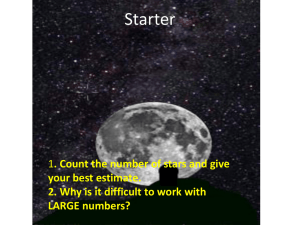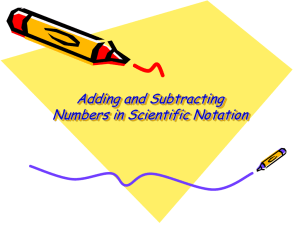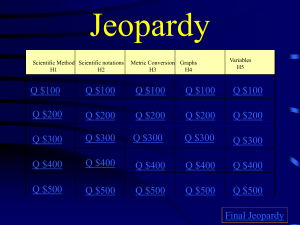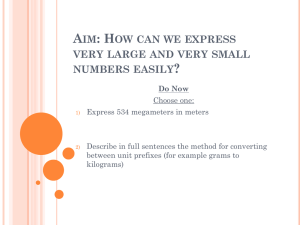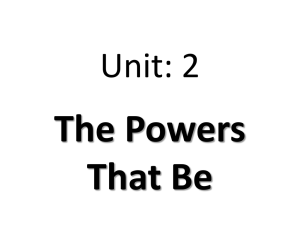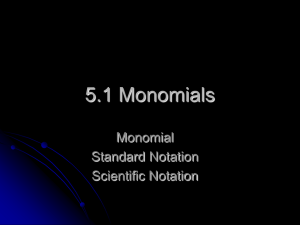Unit 2, Week 3
advertisement
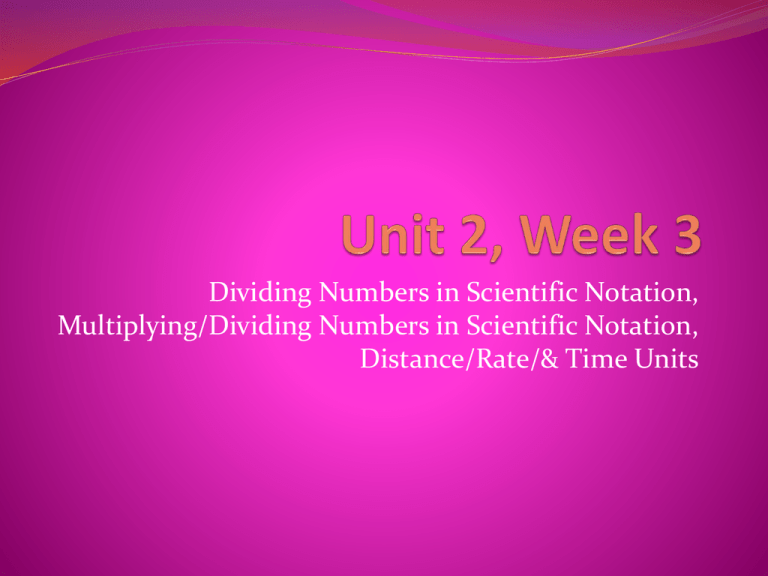
Dividing Numbers in Scientific Notation, Multiplying/Dividing Numbers in Scientific Notation, Distance/Rate/& Time Units Do Now - √4 + √49 /√100 + 7 Please get out your guided notes from last week. Respond to Wednesday’s Do Now: 1. Write an expression for the product of these two numbers: (3.2x109) & (2.9x104) DO NOT SOLVE! 1. Solve. (2.4x105) x (5.2x107) Class Averages 100 90 80 70 85 70 88 85 85 85 72 70 66 85 63 68 60 Quiz 1 50 Quiz 2 40 Big Goal 30 20 10 0 3rd Period 5th Period 6th Period 7th Period 85% of Higher MATHLETES! 3rd Period 5th Period Gerardo Torez Chyna Katelyn Dezmond Solomon Luke Reggie DeRico Abdul Jalen Vicki Wesley Ceirsten Mario 6th Period Jaycee Mallory Ellie 7th Period Autumn Grace Jordan 100% Math All-Stars! 3rd Period JaWaun 5th Period 6th Period Tristan Tylesha Aliciah Steven Freeman Jayla Brandon Jim 7th Period Kalei Jack Tracking Your Quiz You are to track your quiz on your own. Please write down your class average so you can do this on your own time. 3rd period – 66% 5th period – 86% 6th period – 63% 7th period – 68% Week Agenda Monday – Dividing Numbers in Scientific Notation Tuesday – Simplifying Scientific Notation Expressions Wednesday – Adding/Subtracting Numbers in Scientific Notation Thursday – Scientific Notation Word Problems Friday - Quiz Today’s Agenda Do Now – 6 minutes Quiz Return/ Shout Outs – 4 minutes Agenda – 1 minutes Rules of Exponents – 5 minutes Dividing Numbers in Scientific Notation INM - 10 minutes Dividing Numbers in Scientific Notation GP & IP – 15 minutes Exit Ticket – 5 minutes Today’s Objective SWBAT divide numbers in scientific notation. Computing with Scientific Notation Last week we worked with adding numbers in scientific notation and today we will divide numbers in scientific notation. Like last week, we will learn hand motions to help us remember the concept. Dividing Exponents When divide numbers with different exponents, you simply subtract the exponents, if the base number is the same. Example 1: 10315 ÷ 10-10 If the base number is the same, you subtract the exponents. Solution: ____________________ Examples 2: 103 ÷ 10-4 If the base number is the same, you subtract the exponents. Solution: ____________________ Examples 3: 10-20 ÷ 103 If the base number is the same, you subtract the exponents. Solution: ____________________ Dividing Numbers in Scientific Notation If you remember, there are two factors to a number in scientific notation: Factor 1: A number that is greater than 1, but less than 10. 2. Factor 2: A power of 10. 1. When you divide numbers in scientific notation, we divide all factor 1 numbers, and then subtract the exponents of factor 2 together. Dividing Numbers in Scientific Notation Example 4: (8.4 x 103) ÷ (2.1 x 10-4) First, we ID our factor 1 numbers. 8.4 & 2.1 Second, we divide our factor 1 numbers. 8.4 ÷ 2.1 = 4 This is now our new factor 1 of our quotient. Third, we divide the numbers with exponents. 103 ÷ 10-4 Remember we subtract the exponents when the base is the same. 10 (3-(-4)) = 107 Fourth, we combine our factors to get our final answer. Factor 1: 4 Factor 2: 107 Final answer: 4 x 107 Dividing Numbers in Scientific Notation Example 5: (1.8 x 10 ) ÷ (7.5 x 10 ) 6 2 First, we ID our factor 1 numbers. 1.8 & 7.5 Second, we divide our factor 1 numbers. 1.8 ÷ 7.5 = .24 This is now our new factor 1 of our quotient. Third, we divide the numbers with exponents. 106 ÷ 102 Remember we subtract the exponents when the base is the same. 10 (6-2) = 104 Fourth, we combine our factors to get our final answer. Factor 1: .24 Factor 2: 104 Temporary Final answer: .24 x 104 But your answer MUST BE IN CORRECT scientific notation form. We need to move the decimal point one place to the right so our factor 1 is greater than 1, but less than 10 2.4 When we do this, we must account for the change in factor 2. Factor 2 goes from 104 to 1o3. Actual final answer: 2.4 x 103 Dividing Numbers in Scientific Notation Example 6: (1.2 x 10-8) ÷ (9.6 x 1012) First, we ID our factor 1 numbers. 1.2 & 9.6 Second, we divide our factor 1 numbers. 1.2 ÷ 9.6 = .125 This is now our new factor 1 of our quotient. Third, we divide the numbers with exponents. 10-8 ÷ 1012 Remember we subtract the exponents when the base is the same. 10 (-8-12) = 10-20 Fourth, we combine our factors to get our final answer. Factor 1: .125 Factor 2: 10-20 Temporary Final answer: .125 x 10-20 But your answer MUST BE IN CORRECT scientific notation form. We need to move the decimal point one place to the right so our factor 1 is greater than 1, but less than 10 1.25 When we do this, we must account for the change in factor 2. Factor 2 goes from 10-20 to 1o-21. Actual final answer: 1.25 x 10-21 Dividing Numbers in Scientific Notation Example 7: (3.4 x 103) ÷ (6.8 x 10-2) First, we ID our factor 1 numbers. 3.4 & 6.8 Second, we divide our factor 1 numbers. 3.4 ÷ 6.8 = .5 This is now our new factor 1 of our quotient. Third, we divide the numbers with exponents. 103 ÷ 10-2 Remember we subtract the exponents when the base is the same. 10 (3-(-2) = 105 Fourth, we combine our factors to get our final answer. Factor 1: .5 Factor 2: 105 Temporary Final answer: .5 x 105 But your answer MUST BE IN CORRECT scientific notation form. We need to move the decimal point one place to the right so our factor 1 is greater than 1, but less than 10 5 When we do this, we must account for the change in factor 2. Factor 2 goes from 105 to 104. Actual final answer: 5 x 104 Dividing Numbers in Scientific Notation Example 8: (9 x 10 ) ÷(2.4 x 10 ) -11 8 Dividing Numbers in Scientific Notation Example 9: (9.45 x 10 ) ÷(1.5 x 10 ) 10 6 Dividing Numbers in Scientific Notation Work on this one with your partner. Example 10: (3.24 x 10-4) ÷(8.1 x 10-7) Dividing Numbers in Scientific Notation Work on this one with your partner. Example 11: (4.2 x 10-8) ÷(1.68 x 10-2) Dividing Numbers in Scientific Notation Work on this one on your own. Example 12: (4.64 x 10-4) ÷(2.9 x 10-6) Dividing Numbers in Scientific Notation Work on this one on your own. Example 13: (3.7x 105) ÷ (2.9 x 1011) Dividing Numbers in Scientific Notation Example 14: Which one of these expressions correctly identifies the quotient of these two numbers x 10-2) ÷ (9.5 x 10-4)? a) (7.9 x 9.5) x 10(-2+-4) b) (7.9 x 9.5) x 10(-2--4) c) (7.9 ÷ 9.5) x 10(-2+-4) d) (7.9 ÷ 9.5) x 10(-2--4) (7.9 Exit Ticket Each of you will complete your exit ticket on a note card. There are 3 problems. You will complete the exit ticket in 5 minutes and it must be turned in before you can exit the classroom. You must work SILENTLY and INDEPENDENTLY. HOMEWORK – Math Book Page 120: #s 5-8 & 20-25! Exit Ticket 1. (3.4 X 106) ÷ (2 X 108) = 2. (4.8 X 10-5) ÷ (3.2 X 10-6) = 3. (10.5 X 1020) ÷ ( 1.2 X 10-14) = HOMEWORK – Math Book Page 120: #s 5-8 & 20-25 & STUDY FOR QUIZ! Do Now - √81 / √81+√81 Please pick up your guided notes and respond to the following SILENTLY & INDEPENDENTLY. 1. Solve. (6.5 x 10-6) (4.5 x 109) 2. Solve. (5.6 10 ) 5 (10 .5 10 ) 12 Today’s Agenda Do Now – 6 minutes Agenda – 1 minutes Computing Numbers in Scientific Notation Investigation – 10 minutes Computing Numbers in Scientific Notation IP – 5 minutes GP & IP – 14 minutes Exit Ticket – 5 minutes Today’s Objective SWBAT simplify scientific notation expressions. Math Investigation You are in groups of 4. Together, you will work together to try to solve the problem given to you. You may use your notes, your partners, but not your calculators. Together, you CAN solve the problem – Use your rules of exponents to help you! I will be cycling around to monitor your progress and check your final answers. Simplifying Scientific Notation Expressions (2 10 )( 3 10 ) 3 7 8 Example 1: Simplify. (2 10 ) First, we take care of the numerator. Multiply the factor 1 numbers: 2 x 3 = 6 Multiply factor 2 numbers by adding exponents: 10-3 x 107 = 104 Combine both factors to get your product: 6 x 104 Second, divide your new product by the denominator. Your new problem is: 6 10 4 2 10 8 Divide factor 1 numbers: 6 ÷2 = 3 Divide factor 2 numbers by subtracting exponents: 10(4-(-8)) = 1012 Last, combine your factors. Final answer:3 x 1012 Simplifying Scientific Notation Expressions (6 10 )( 2 10 ) 4 7 10 Example 2: Simplify. (4 10 ) First, we take care of the numerator. Multiply the factor 1 numbers: 6 x 2 = 12 Multiply factor 2 numbers by adding exponents: 104 x 107 = 1011 Combine both factors to get your product: 12 x 1011 Second, divide your new product by the denominator. 11 Your new problem is: 12 10 4 10 Divide factor 1 numbers: 12 ÷4 = 3 Divide factor 2 numbers by subtracting exponents: 10(11-10) = 101 10 Last, combine your factors. Final answer: 3 x 101 Simplifying Scientific Notation Expressions (7 10 )(1 10 ) 12 6 8 Example 3: Simplify. (14 10 ) First, we take care of the numerator. Multiply the factor 1 numbers: 7 x 1 = 7 Multiply factor 2 numbers by adding exponents: 10-12 x 106 = 10-6 Combine both factors to get your product: 7 x 10-6 Second, divide your new product by the denominator. Your new problem is: 7 10 6 14 10 8 Divide factor 1 numbers: 7 ÷14 = 0.5 Divide factor 2 numbers by subtracting exponents: 10(-6-(-8)) = 102 Last, combine your factors. Final answer: 0.5 x 102 CORRECT SCIENTIFIC NOTATION ANSWER: 5 x 101 Simplifying Scientific Notation 9 7 Expressions (5 10 )( 6 10 ) Example 4: Simplify. ( 3 10 ) 5 Simplifying Scientific Notation 5 10 Expressions (8 10 )( 4 10 ) Example 5: Simplify. (8 10 ) 9 Simplifying Scientific Notation 17 10 Expressions (5 10 )( 4 10 ) Example 6: Simplify. (2 10 ) 5 Simplifying Scientific Notation 7 14 Expressions (9 10 )( 4 10 ) Example 7: Simplify. (6 10 ) 4 Simplifying Scientific Notation 7 14 Expressions (5.6 10 )( 3.6 10 ) Example 8: Simplify. (5 10 ) 4 Simplifying Scientific Notation Expressions (6.4 10 )( 2.9 10 ) 5 Example 9: Simplify. 12 (9.8 10 ) 5 Simplifying Expressions in Scientific Notation (4.8 10 )( 3.9 10 ) 8 Example 10: Simplify. 4 (7 10 ) 3 Exit Ticket Each of you will complete your exit ticket on a note card. There are 2 problems. You will complete the exit ticket in 5 minutes and it must be turned in before you can exit the classroom. You must work SILENTLY and INDEPENDENTLY. HOMEWORK – Worksheet! Exit Ticket (2.7 10 7 )( 5.2 10 ) 12 (2 10 (1.6 10 8 8 ) )( 3 10 ) 9 ( 5 10 ) 2 Do Now 1. 2. 3. 4. 5. 3x – 10 = 17 5x – 10 = -20 -½ x + 8 = -4 ¾x + 9 = 35 -9= 8 – 16x Do Now – (√9)2 /√361/√16 + √64 Please respond to the following on the Wednesday area of your guided notes SILETNLY & INDEPENDENTLY. 1. Simplify. (4.6 10 3 )( 3.2 10 7 ) (7 10 ) 9 2. Write the steps to the problem you just solved above. Today’s Agenda Do Now – 8 minutes Agenda – 1 minutes Adding & Subtracting Number in Scientific Notation INM – 10 minutes GP & IP – 26 minutes Exit Ticket – 5 minutes Today’s Objective SWBAT add and subtract number in scientific notation. Adding and Subtracting Numbers in Scientific Notation After multiplying, dividing, and combining operations with numbers in scientific notation, we will finish computing with the numbers by adding and subtracting them. Before we begin, work with your partner and come up with 2 examples of where we would need to add and subtract numbers in scientific notation. Adding and Subtracting Numbers in Scientific Notation There are two different ways to adding and subtract numbers in scientific notation. I will model both to you, and then you can chose which one works best for you! Adding and Subtracting Numbers in Scientific Notation Example 1: (6.89 x 104) + (9.24 x 105) Method One: Convert all numbers into standard form. 1. 6.89 x 104 = 68,900 9.24 x 105 = 924,000 2. Complete the operation indicated to solve. 68,900 + 924,000 = 992,900 Adding and Subtracting Numbers in Scientific Notation Example 2: (6.89 x 104) + (9.24 x 105) Method Two: 1. Check to see if the powers of 10 have the same exponent. 2. Convert numbers to the same by power of 10 by moving the decimal point. 6.89 x 104 = 6.89 x 104 9.24 x 105 = I want the power to be 4, so I need to subtract 1 from the exponent. When I subtract I move the decimal right. = 92.4 x 104 Add the factor ones and keep the power of ten to solve. 3. 92.4 + 9.89 = 99.29 x 104 Convert to proper scientific notation form. 4. 99.29 x 104 = 9.929 x 105 Adding and Subtracting Numbers in Scientific Notation After seeing both methods, I want you to think, why would I want to know how to use both methods? When would the standard form method be useful? When would the exponent method be useful? You will have one minute to think about this with your partner. Adding and Subtracting Numbers in Scientific Notation Example 3: (7.38 x 108) – (1.161 x 107) Method 1 Method 2 Adding and Subtracting Numbers in Scientific Notation Example 4: (8.41 x 103) + (9.71 x 104) Method 1 Method 2 Adding and Subtracting Numbers in Scientific Notation Work on this one with your partner. Example 5: (1.263 x 109) – (1.525 x 107) Adding and Subtracting Numbers in Scientific Notation Work on this one with your partner. Example 6: (2.85 x 107) + (1.61 x 109) Adding and Subtracting Numbers in Scientific Notation Work on this one with your partner. Example 7: (8.23 x 106) + (6.91 x 105) Adding and Subtracting Numbers in Scientific Notation Work on this one on your own. Example 8: (4.9 x 1018) + (5.8 x 1015) Adding and Subtracting Numbers in Scientific Notation Work on this one on your own. Example 9: (9.3 x 10-5) – (3.25 x 10-3) Adding and Subtracting Numbers in Scientific Notation Work on this one on your own. Example 10: (5.12 x 10-4) – (2.9 x 10-3) Adding and Subtracting Numbers in Scientific Notation Work on this one on your own. Example 11: (4.1 x 10-2) + (8.4 x 10-3) Adding and Subtracting Numbers in Scientific Notation Work on this one on your own. Example 12: (3.5 x 1013) + (7.3 x 1012) Exit Ticket Each of you will complete your exit ticket on a note card. There are 2 problems. You will complete the exit ticket in 5 minutes and it must be turned in before you can exit the classroom. You must work SILENTLY and INDEPENDENTLY. HOMEWORK – Math book page 120: 10 – 13 & page 121: 28 - 35! Exit Ticket 1. (2.18 x 1010) – (5.61 x 108) 2. (6.85 x 106) + (9.7 x 105) HOMEWORK – Math book page 120: 10 – 13 & page 121: 28 - 35! Do Now – 2 3 / 2 4 + 2 2 Please get out your guided notes and respond to the following on the Thursday area SILENTLY & INDEPENDENTLY. 1. (3.5 x 104) + (2.76 x 105) 2. (7.34 x 1015) – (4.67 x 1014) Today’s Agenda Do Now – 8 minutes Agenda – 1 minute Scientific Notation Word Problems INM – 10 minutes GP & IP – 25 minutes Exit Ticket – 5 minutes Quiz Topics – 1 minute Today’s Objective SWBAT solve word problems involving scientific notation. Scientific Notation Word Problems Example 1: In 2006, Blue Ridge Parkway was visited by about 1.9 x 107 people. That same year, Great Smoky Mountains National Park was visited by about 9.3 x 106 people. How many more people visited Blue Ridge Parkway than Great Smoky Mountains National Park in 2006? What operation will be used to solve this problem? Scientific Notation Word Problems Example 2: In 2006, the US had a Gross Domestic Product (GDP) of 1.313 x 1013. The United Kingdom had a GDP of 1.93 x 1012. What were the combined GDPs of the US and the UK in 2006? What operation will be used to solve this problem? Scientific Notation Word Problems Example 3: One cell has a diameter of 4.5 x 10-6. If there are 20 cells growing in a lab, what is their combined diameters? What operation will be used to solve this problem? Scientific Notation Word Problems Example 4: The average distance from Earth to the Sun is 1.46 x 108 kilometers. The average distance from Earth to the Moon is 3.84 x 105 kilometers. About many more times as great is the distance from Earth to the Sun than to the Moon? What operation will be used to solve this problem? Scientific Notation Word Problems Example 5: About 8.73 x 108 people in the world speak Chinese. About 3.22 x 108 speak Spanish. In scientific notation, how many more people speak Chinese than Spanish? What operation will be used to solve this problem? Scientific Notation Word Problems Example 6: Great Lake Superior covers an area of 3.17 x 104 square miles. The smallest Great Lake, Ontario, covers an area of 7.34 x 103 square miles. About how many times as great is the area covered by Lake Superior than Lake Ontario? What operation will be used to solve this problem? Scientific Notation Word Problems Example 7: The income following incomes are recorded for music artists in 2010. Artist 2010 Income Jay-Z 2.56 x 107 Yo Gotti 5.1 x 106 How much more money did Jay-Z make over Yo Gotti? What operation will be used to solve this problem? Scientific Notation Word Problems Example 8: The distance between Memphis and Sand Francisco is 1.2 x 103 miles. The distance between Memphis and Nashville is 2.5 x 102. How much further is San Francisco than Nashville from Memphis? What operation will be used to solve this problem? Scientific Notation Word Problems Example 9: The largest planet in our solar system is Jupiter with a diameter of about 1.43 x 105 kilometers. The smallest planet in our solar system is Mercury with a diameter of about 4.9 x 103 kilometers. About how many times greater is the diameter of Jupiter than the diameter of Mercury? What operation will be used to solve this problem? Scientific Notation Word Problems Example 10: In 2006, China had 1.311 x108 internet users. That same year, Japan had 9.09 x 107 internet users. How many internet users did the two countries have combined? What operation will be used to solve this problem? Scientific Notation Word Problems Example 11: With nearly 3.0 x 108 books, the Library of Congress is the largest library in the US. The University of Tennessee has about 2.97 x 107 books in its library. How many more books does the Library of Congress have than the University of Tennessee? What operation will be used to solve this problem? Exit Ticket Each of you will complete your exit ticket on a note card. There are 2 problems. You will complete the exit ticket in 5 minutes and it must be turned in before you can exit the classroom. You must work SILENTLY and INDEPENDENTLY. HOMEWORK – Worksheet & Study for Quiz! Exit Ticket 1. The average distance from star A to the star B is 3.56 x 109 kilometers. The average distance from Star A to Star C is 4.8 x 1012 kilometers. About much further is the distance from Star A to Star C than to Star B? What operation will be used to solve this problem? 2. In 2010, USA had 2.31 x105 IPhone users. That same year, Europe had 1.49 x 104 IPhone users. How many IPhone users did the USA and Europe have combined? What operation will be used to solve this problem? Homework – Worksheet & Study! Do Now - √81 / √25 - 2 2 Please clear off your desk of everything except a pencil, calculator, and a plain sheet of paper (to cover your quiz with). The longer it takes you to complete this, the less time you will have for your quiz.


